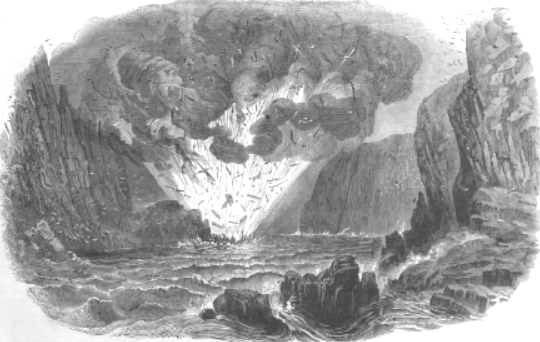
Wooden brig Lily of Liverpool, 169 tons, 13 crew, owned Hatton &
Cookson, Liverpool.
Voyage Liverpool to Ambriz (SW Africa) with gunpowder, etc. Master
John Owens (aged 45).
Lloyds register up to 1852 has a brig Lily of 162 tons, built Guernsey 1840.
Driven back by storms and wrecked on Kitterland, an islet, in
Calf Sound, Isle of Man on 27 December 1852.
8 crew got ashore on Kitterland, 5 were lost.
The 8 survivors, 2 of them injured, were rescued by fishermen from
Port St. Mary.
During salvage of the wreck, on 28th December 1852, the cargo
exploded, killing 29 of the salvors, only one being saved.
A memorial at Kirk Christ Church, Rushen, churchyard commemorates the
29 Manxmen lost.
Isle
of Man postage stamp commemorating this wreck.
Liverpool newspapers describe Lilly[sic], master Owen, 197 tons, loading for Africa, and leaving Liverpool on 23 December 1852. Her cargo consisting chiefly of bales of cloth, cottons, rum, cannon, firearms, and upwards of forty tons of gunpowder. She is described as beating about in the channel, in stormy weather, before being driven into Calf Sound where she hit Kitterland and was wrecked. Later reports describe her as brig Lily. Her destination is described as the coast of Africa - variously written Ambrazo or Ambrize - note Ambriz is a port in Angola.
Image of explosion, from Illustrated London News:

[from Liverpool Mercury - Tuesday 04 January 1853}:
THE WRECK AND EXPLOSION OF THE SHIP LILY, OF LIVERPOOL.
We gave in our last some of the particulars of the
melancholy accident which took place yesterday week off
the Calf of Man. The Rev. R. Moss, curate of Port St.
Mary, has issued a circular soliciting subscriptions in behalf of
the families of the men who lost their lives. The rev gentleman says -
On Monday, the 27th ultimo, about half-past ten in the
morning, the
ship Lily of Liverpool, John Owen, master, freighted with gunpowder,
etc, and bound for the West coast of Africa, struck on Kitterland, a
small uninhabited island in the Sound, between the Isle and Calf of
Man. In a few minutes, she was a total wreck. The master, carpenter,
cook, and two boys [one named as John George Owens, aged 16, related to
the master] perished in the waves. At four o'clock in the
afternoon, a number of our most able fishermen, at the risk of their
lives, ventured across the Sound in two small boats, and succeeded in
bringing the rest of the crew, eight in number, in safety to the
mainland. These were all brought to Port St. Mary, and had every
attention paid them by those brave fellows who had liberated them
from the barren island, where, in all probability, the second mate,
who had a leg fractured, and had lost a considerable quantity of
blood, and an ordinary seaman, upon whom the mast had fallen, would
have perished before morning.
Early on Tuesday, a number of men were employed by the
proper authorities to save as much of the cargo as they could.
At eight o'clock, a.m., by some means or other; which must
for ever remain a secret to us, upwards of 30 tons of gunpowder
exploded. The ship was shattered in pieces, not a vestige of
her remaining on the rocks, whither the waves had driven her.
Bales of goods on fire were seen like meteors in the air,
fragments of which fell miles distant from the place; and of
the 30 men employed about the wreck, little was found, save one
man just alive, and three dead bodies, the rest having been
blown to atoms. Thus in an instant 29 men, many of whom so
nobly exerted themselves to save their fellow-men the
night before, were bereft of life, upwards of 20 women of their
husbands, 68 children of their fathers, and Port St. Mary of
its choice men; and to add to the calamity, many families are
left quite destitute. On behalf of these unhappy families I now
appeal to the Christian sympathy and liberality of the people
of England, unto whom, as an Englishman, I am proud to say
the voice of real distress has never yet been raised in vain.